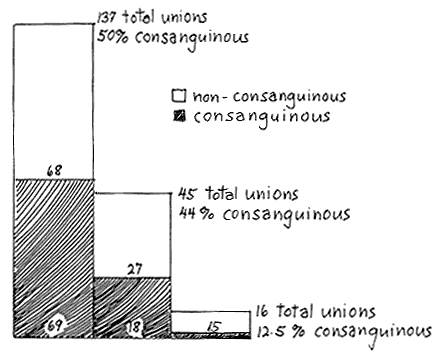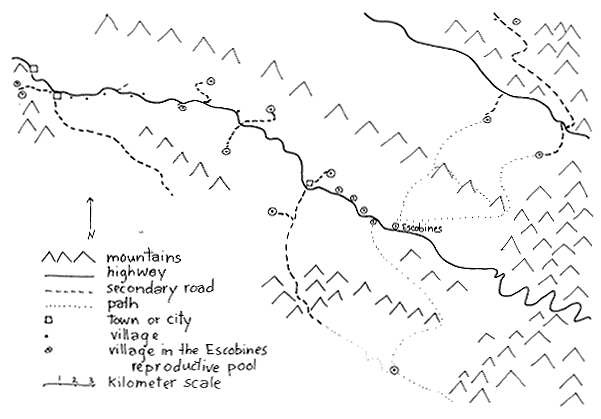The Restricted Reproductive Pool: Demography and Consanguinity
Consanguinity must be appreciated against a demographic backdrop (fig. 6). According to our 1972 census, there were 783 Escobinos distributed over 232 households.[10] One hundred ninety-eight of these households represented marital unions formed around living couples or by the remaining widowed spouse.[11] These couples, grouped by age, manifested decreasing consanguinity with decreasing age. My criteria of consanguinity were twofold:

Fig. 6.
Age Pyramid of Escobines, 1972
(1) that the couple or widowed individual recognize the "blood" relationship, saying, for example, somos algo de familia (we are somewhat related), and (2) that the relationship be traceable.
As already discussed, there are problems in quantifying IDD where much of the population has not been treated, where IDD is not a reportable disease, where goiter is a stigma, and where the gradations of defect and deformity in the population cannot be clinically assessed. Nevertheless, by visual inspection alone, it was clear that the majority, 56 percent, of married women and widows age forty and older were goitrous (i.e., had goiters of grade 2, 3, or 4), as were a noticeable number of younger women, perhaps 20 percent.[12] A number of younger women, goitrous or not, sought medical attention for a variety of symptoms, receiving treatment directed at the thyroid. Six people were congenitally deaf: five were men, and one was a woman. Clinical and biochemical tests run by health authorities on this population showed low enough levels of T3 and T4 to warrant emergency intervention (see chap. 7).
As can be seen in figure 7, 50 percent of the couples age forty or above were consanguinous, as were 44 percent of those in their thirties and only 12.5 percent of those in their twenties.[13] The majority of Escobines marriages concluded since 1972 have drawn spouses from outside the parish, and none have been concluded, as formerly, to favor the reunification of property. Young Escobinas refuse to marry men exclusively dedicated to cultivation and herding; hence, no young couples now make their living exclusively from the land. In Escobines, the trend away from consanguinous unions has probably been more precipitous than in other nearby villages where modernization arrived more gradually, for a very successful village dance hall known as La Pista, the "dancing field," has, since the late 1960s, been drawing increasing numbers of young people from far downriver. Young Escobinos, even those who are university students, now tend to meet at La Pista the outsiders they eventually marry.[14]
It is now important to point out that more than "convenience" and lack of appropriate unrelated partners account for the high consanguinity of the recent past. Emigration, going on for well over a century, introduced villagers to a wide field of possible partners abroad. Yet only two of those men who emigrated be-

Fig. 7.
Declining Incidence of Consanguineous Unions
tween the turn of the century and the Civil War brought home a spouse from elsewhere.[15] The other returnees drew spouses from the small pool of cousins, fellow villagers, and parishioners. A few drew spouses from outside the parish, from villages at nearby higher elevations (see fig. 8), where people were exposed to the same environmental hazards and economic conditions as in Escobines. Escobinos also found spouses at lower elevations; close examination revealed, however, that these were nearly exclusively drawn from villages popularly known as afflicted with goiter.
Figure 8 shows that not every settlement[16] at a convenient distance forms part of that pool. Towns were not part of the pool, nor, with two exceptions, were the villages situated close to the downriver industrial centers long served by commerce. These two exceptional villages, perhaps because they were caught in an intricate fold of mountains whose topography made transport difficult or whose geology made for a particularly high load of goitrogens,

Fig. 8.
The Larger Pool from which Escobines Spouses Were Drawn
stand out in a turn-of-the-century record as having an uncommonly high, 90 percent, prevalence of goiter (Fernández-Ruiz 1965).
The people in this reproductive pool numbered about 3,000. They shared common characteristics of elevation, lifeway, and diet—factors shared by many other Asturian villages in the higher reaches of this watershed, populated in 1970 by about 25,000 (GEA s.v. Aller). This larger number did not, however, form part of the restricted reproductive pool, a fact that asks us to consider what additional common denominator distinguished the villages in the pool but not the other nearby villages.
The widely quoted refrain, "No goiter, not beautiful," might at face value suggest a special preference for the goitrous or those likely to become goitrous. But any preference for goitrous partners is ruled out when we notice that goitrousness is feared and, when possible, avoided or remedied. Endogamy and endemic villages may be better explained by exclusion: prevalence of severe endemic goiter excludes villagers from the general reproductive pool of the vicinity and channels courtship into similarly afflicted villages.